From its beginnings in a schoolhouse in lower Manhattan, Columbia University has grown to encompass two principal campuses: the historic, neoclassical campus in the Morningside Heights neighborhood and the modern Medical Center further uptown, in Washington Heights. Today, Columbia is one of the top academic and research institutions in the world, conducting pathbreaking research in medicine, science, the arts, and the humanities. It includes three undergraduate schools, thirteen graduate and professional schools, and a school of continuing education.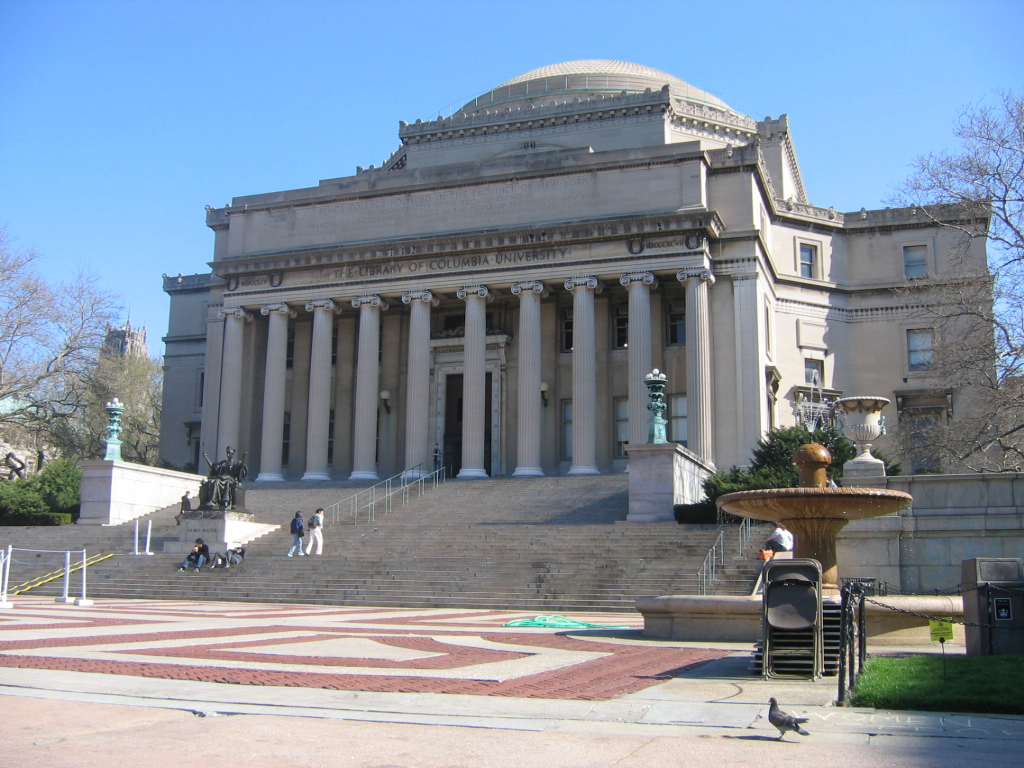
MISSION STATEMENT
Columbia University is one of the world’s most important centers of research and at the same time a distinctive and distinguished learning environment for undergraduates and graduate students in many scholarly and professional fields. The University recognizes the importance of its location in New York City and seeks to link its research and teaching to the vast resources of a great metropolis. It seeks to attract a diverse and international faculty and student body, to support research and teaching on global issues, and to create academic relationships with many countries and regions. It expects all areas of the university to advance knowledge and learning at the highest level and to convey the products of its efforts to the world.
A BRIEF HISTORY OF COLUMBIA
Columbia University was founded in 1754 as King’s College by royal charter of King George II of England. It is the oldest institution of higher learning in the state of New York and the fifth oldest in the United States.
Controversy preceded the founding of the College, with various groups competing to determine its location and religious affiliation. Advocates of New York City met with success on the first point, while the Anglicans prevailed on the latter. However, all constituencies agreed to commit themselves to principles of religious liberty in establishing the policies of the College.
![]()
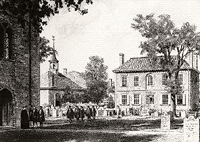
Columbia’s first home
Trinity Church schoolhouse![]()
In July 1754, Samuel Johnson held the first classes in a new schoolhouse adjoining Trinity Church, located on what is now lower Broadway in Manhattan. There were eight students in the class. At King’s College, the future leaders of colonial society could receive an education designed to “enlarge the Mind, improve the Understanding, polish the whole Man, and qualify them to support the brightest Characters in all the elevated stations in life.” One early manifestation of the institution’s lofty goals was the establishment in 1767 of the first American medical school to grant the M.D. degree.
The American Revolution brought the growth of the college to a halt, forcing a suspension of instruction in 1776 that lasted for eight years. However, the institution continued to exert a significant influence on American life through the people associated with it. Among the earliest students and trustees of King’s College were John Jay, the first chief justice of the United States; Alexander Hamilton, the first secretary of the treasury; Gouverneur Morris, the author of the final draft of the U.S. Constitution; and Robert R. Livingston, a member of the five-man committee that drafted the Declaration of Independence.
![]()
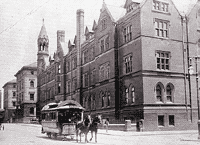
Columbia’s third home
East 49th St. and Madison Ave.
![]()
The college reopened in 1784 with a new name—Columbia—that embodied the patriotic fervor that had inspired the nation’s quest for independence. The revitalized institution was recognizable as the descendant of its colonial ancestor, thanks to its inclination toward Anglicanism and the needs of an urban population, but there were important differences: Columbia College reflected the legacy of the Revolution in the greater economic, denominational, and geographic diversity of its new students and leaders. Cloistered campus life gave way to the more common phenomenon of day students who lived at home or lodged in the city.
In 1857, the College moved from Park Place, near the present site of city hall, to Forty-ninth Street and Madison Avenue, where it remained for the next forty years. During the last half of the nineteenth century, Columbia rapidly assumed the shape of a modern university. The Columbia School of Law was founded in 1858. The country’s first mining school, a precursor of today’s Fu Foundation School of Engineering and Applied Science, was established in 1864 and awarded the first Columbia Ph.D. in 1875.
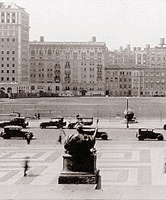
Columbia’s fourth home
Morningside Heights
![]()
![]()
When Seth Low became Columbia’s president in 1890, he vigorously promoted the university ideal for the College, placing the fragmented federation of autonomous and competing schools under a central administration that stressed cooperation and shared resources. Barnard College for women had become affiliated with Columbia in 1889; the medical school came under the aegis of the University in 1891, followed by Teachers College in 1893. The development of graduate faculties in political science, philosophy, and pure science established Columbia as one of the nation’s earliest centers for graduate education. In 1896, the trustees officially authorized the use of yet another new name, Columbia University, and today the institution is officially known as Columbia University in the City of New York.
Low’s greatest accomplishment, however, was moving the university from Forty-ninth Street to the more spacious Morningside Heights campus, designed as an urban academic village by McKim, Mead, and White, the renowned turn-of-the-century architectural firm. Architect Charles Follen McKim provided Columbia with stately buildings patterned after those of the Italian Renaissance. The University continued to prosper after its move uptown in 1897.
![]()
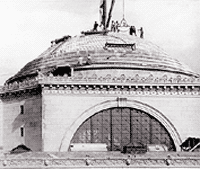
The construction of
Low Memorial Library
![]()
During the presidency of Nicholas Murray Butler (1902–1945), Columbia emerged as a preeminent national center for educational innovation and scholarly achievement. The School of Journalism was established by bequest of Joseph Pulitzer in 1912. John Erskine taught the first Great Books Honors Seminar at Columbia College in 1919, making the study of original masterworks the foundation of undergraduate education, and in the same year, a course on war and peace studies originated the College’s influential Core Curriculum.
Columbia became, in the words of College alumnus Herman Wouk, a place of “doubled magic,” where “the best things of the moment were outside the rectangle of Columbia; the best things of all human history and thought were inside the rectangle.”
The study of the sciences flourished along with the liberal arts. Franz Boas founded the modern science of anthropology here in the early decades of the twentieth century, even as Thomas Hunt Morgan set the course for modern genetics. In 1928, Columbia–Presbyterian Medical Center, the first such center to combine teaching, research, and patient care, was officially opened as a joint project between the medical school and The Presbyterian Hospital.
By the late 1930s, a Columbia student could study with the likes of Jacques Barzun, Paul Lazarsfeld, Mark Van Doren, Lionel Trilling, and I. I. Rabi, to name just a few of the great minds of the Morningside campus. The University’s graduates during this time were equally accomplished—for example, two alumni of Columbia’s School of Law, Charles Evans Hughes and Harlan Fiske Stone (who was also dean of the School of Law), served successively as Chief Justice of the United States Supreme Court.
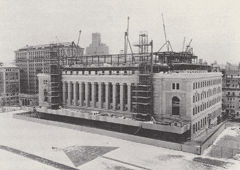
The construction of South Hall
(later renamed Butler Library)
![]()
![]()
Research into the atom by faculty members I. I. Rabi, Enrico Fermi, and Polykarp Kusch brought Columbia’s Department of Physics to international prominence in the 1940s. The founding of the School of International Affairs (now the School of International and Public Affairs) in 1946 marked the beginning of intensive growth in international relations as a major scholarly focus of the University. The oral-history movement in the United States was launched at Columbia in 1948.
Columbia celebrated its bicentennial in 1954 during a period of steady expansion. This growth mandated a major campus building program in the 1960s, and, by the end of the decade, five of the University’s schools were housed in new buildings.
![]()
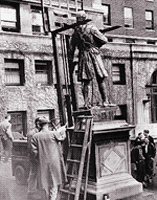
Statue of Alexander
Hamilton, Hamilton Hall
![]()
It was also in the 1960s that Columbia experienced the most significant crisis in its history. Currents of unrest sweeping the country—among them opposition to the Vietnam War, an increasingly militant civil rights movement, and the ongoing decline of America’s inner cities—converged with particular force at Columbia, casting the Morningside campus into the national spotlight. More than 1,000 protesting students occupied five buildings in the last week of April 1968, effectively shutting down the University until they were forcibly removed by the New York City police. Those events led directly to the cancellation of a proposed gym in Morningside Park, the cessation of certain classified research projects on campus, the retirement of President Grayson Kirk, and a downturn in the University’s finances and morale. They also led to the creation of the University Senate, in which faculty, students, and alumni acquired a larger voice in University affairs.
In recent decades, Columbia’s campuses have seen a revival of spirit and energy that have been truly momentous. Under the leadership of President Michael Sovern, the 1980s saw the completion of important new facilities, and the pace intensified after George Rupp became president in 1993. A 650-million-dollar building program begun in 1994 provided the impetus for a wide range of projects, including the complete renovation of Furnald Hall and athletics facilities on campus and at Baker Field, the wiring of the campus for Internet and wireless access, the rebuilding of Dodge Hall for the School of the Arts, the construction of new facilities for the Schools of Law and Business, the renovation of Butler Library, and the creation of the Philip L. Milstein Family College Library.
The University also continued to develop the Audubon Biotechnology and Research Park, securing Columbia’s place at the forefront of medical research. As New York City’s only university-related research park, it also is contributing to economic growth through the creation of private-sector research collaborations and the generation of new biomedically related business.
A new student-activities center, Alfred Lerner Hall, opened in 1999 and features the Roone Arledge Auditorium and Cinema. Current building projects include major renovations to Hamilton Hall and Avery Library.
These and other improvements to the University’s physical plant provide a visible reminder of the continuing growth and development of Columbia’s programs of research and teaching. From its renowned Core Curriculum to the most advanced work now under way in its graduate and professional schools, the University continues to set the highest standard for the creation and dissemination of knowledge, both in the United States and around the world.
Clear in its commitment to carrying out such a wide-ranging and historic mission, and led by a new president, Lee C. Bollinger, Columbia is proud to celebrate its 250th anniversary and look ahead to the achievements to come.
THE COLUMBIA UNIVERSITY CAMPUS

Low Memorial Library
![]()
![]()
In 1897, the university moved from Forty-ninth Street and Madison Avenue, where it had stood for fifty years, to its present location on Morningside Heights at 116th Street and Broadway. Seth Low, the president of the University at the time of the move, sought to create an academic village in a more spacious setting. Charles Follen McKim of the architectural firm of McKim, Mead, and White modeled the new campus after the Athenian agora. The Columbia campus comprises the largest single collection of McKim, Mead & White buildings in existence.
The architectural centerpiece of the campus is Low Memorial Library, named in honor of Seth Low’s father. Built in the Roman classical style, it appears in the New York City Register of Historic Places. The building today houses the University’s central administration offices and the visitors center.
A broad flight of steps descends from Low Library to an expansive plaza, a popular place for students to gather, and from there to College Walk, a promenade that bisects the central campus. Beyond College Walk is the South Campus, where Butler Library, the university’s main library, stands. South Campus is also the site of many of Columbia College’s facilities, including student residences, Alfred Lerner Hall (the student center), and the College’s administrative offices and classroom buildings, along with the Graduate School of Journalism.
To the north of Low Library stands Pupin Hall, which in 1966 was designated a national historic landmark in recognition of the atomic research undertaken there by Columbia’s scientists beginning in 1925. To the east is St. Paul’s Chapel, which is listed with the New York City Register of Historic Places.
Many newer buildings surround the original campus. Among the most impressive are the Sherman Fairchild Center for the Life Sciences and the Morris A. Schapiro Center for Engineering and Physical Science Research. Two miles to the north of Morningside Heights is the 20-acre campus of the Columbia University Medical Center in Manhattan’s Washington Heights, overlooking the Hudson River. Among the most prominent buildings on the site are the 20-story Julius and Armand Hammer Health Sciences Center, the William Black Medical Research Building, and the 17-story tower of the College of Physicians and Surgeons. In 1989, The Presbyterian Hospital opened the Milstein Hospital Building, a 745-bed facility that incorporates the very latest advances in medical technology and patient care.
To the west is the New York State Psychiatric Institute; east of Broadway is the Audubon Biomedical Science and Technology Park, which includes the Mary Woodard Lasker Biomedical Research Building, the Audubon Business Technology Center, Russ Berrie Medical Science Pavilion, and the Irving Cancer Research Center as well as other institutions of cutting-edge scientific and medical research.
In addition to its New York City campuses, Columbia has two facilities outside of Manhattan. Nevis Laboratories, established in 1947, is Columbia’s primary center for the study of high-energy experimental particle and nuclear physics. Located in Irvington, New York, Nevis is situated on a 60-acre estate originally owned by the son of Alexander Hamilton.
The Lamont-Doherty Earth Observatory was established in 1949 in Palisades, New York, and is a leading research institution focusing on global climate change, earthquakes, volcanoes, nonrenewable resources, and environmental hazards. It examines the planet from its core to its atmosphere, across every continent and every ocean.
Academics
Undergraduate education at Columbia is offered through Columbia College, the Fu Foundation School of Engineering and Applied Science, and the School of General Studies. Undergraduate programs are offered by two affiliated institutions, Barnard College and Jewish Theological Seminary. Columbia University provides post-graduate education through thirteen graduate and professional schools and a school of continuing education. Three affiliated schools also offer post-graduate programs.
COLUMBIA SCHOOLS AND AFFILIATED INSTITUTIONS
![]()
Architecture, Planning and Preservation, Graduate School of
Arts and Sciences, Graduate School of
Barnard College (Affiliate)
Continuing Education, School of
Engineering and Applied Science, The Fu Foundation School of
· Postbaccalaureate Premedical Program
International and Public Affairs, School of
Jewish Theological Seminary (Affiliate)
Journalism, Graduate School of
Physicians and Surgeons, College of
Public Health, Mailman School of
Teachers College (Affiliate)
Union Theological Seminary (Affiliate)
Athletics
Columbia University sponsors 29 intercollegiate teams competing in the Ivy League in NCAA Division I (I-AA for football).
OUR VISION
The Department of Intercollegiate Athletics and Physical Education of Columbia University in the City of New York is dedicated to the pursuit of excellence in all its endeavors. We aspire to be an exceptional Intercollegiate Athletics and Physical Education program by offering opportunity for all, valuing integrity in our actions, and providing quality service to all of our constituencies.
OUR MISSION
The Department of Intercollegiate Athletics and Physical Education recognizes that the development of the mind, body and spirit is vital to the Columbia University community. We will:
• Offer athletic and recreational opportunities that meet expectations of excellence
• Foster an inclusive environment that nurtures intellectual growth, physical development and social interaction
• Produce and maintain winning intercollegiate sports programs
• Comply with all NCAA and Ivy League rules and regulations
• Challenge our community to live a healthy and active lifestyle
• Create, sponsor and provide programs to engage our University community and our neighbors
• Develop our student-athletes with values reflecting the richness and diversity of the Columbia community, and
• Live by the guiding principles of the mission of the University; to educate and produce future leaders who will engage the world in a productive and thoughtful manner
OUR VALUES
Consistent with the mission of Columbia University, the Department of Intercollegiate Athletics and Physical Education operates a broad-based program of sports and physical activities that reflect to the extent possible the interest of the student body, the ethical principles of the University and the desires of its internal and external constituents. In carrying out its mission, the following principles shall apply:
• Leadership of the Department will be visionary, decisive, motivating and participatory,
• The Department will promote a safe, hospitable and enjoyable environment for guests and patrons of events and other activities,
• The Department will promote the health, safety and well-being of each participant,
• The Department will develop a clear set of goals that focus on providing excellent customer service through the coherence of goals, incentives, rewards, organizational structures and the presence of effective Departmental processes for assessment and self-improvement,
• Programs will maximize involvement of students, faculty, staff, alumni and friends of the University while recognizing and promoting the enhancement of diversity within the Department,
• Sports programs will promote the highest standards in areas of academic and athletic achievement, personal growth and citizenship,
• Recreational programs will enrich the student experience and contribute to the quality of life throughout the campus and local community,
• The Department will foster the highest level of intercollegiate athletic competition and compete nationally in selected sports,
• The Department staff will endorse integrity and ethics while maintaining a fiscally responsible structure that emphasizes sound leadership, teaching and coaching,
• Programs will respond to the needs and interests of students, outreach goals of the University, competitive rigors of the Ivy League Conference and the financial demands of the ever-changing environment through regular evaluation and assessment and
• The Department will identify, attract and retain staff who exhibit strong commitment to the values of the organization including open and honest communication, high energy, initiative, enthusiasm and creativity.
THE COLUMBIA-BARNARD ATHLETIC CONSORTIUM
Under a unique agreement, women at Barnard College and the undergraduate division of Columbia University compete together as members of University-wide athletic teams. The arrangement, known as a “consortium” under NCAA rules, is one of just three in the nation and is the only one in Division I. It provides the opportunity for female students enrolled at separate colleges to compete within one athletic program while drawing on the resources of all the colleges.
Established in 1983, the consortium was designed to coincide with the admission of women to Columbia College. It was built upon an already established women’s athletic program at Barnard College. By building on that program, the University sought to provide all undergraduate women with the finest competitive opportunities. Both Barnard and Columbia believe that the consortium creates an athletic program within the Ivy League that is far stronger than what either institution could offer individually.
The female student-athlete at Columbia University has a wide variety of educational options to choose from. She may enroll in any of three main undergraduate divisions of the University – Barnard College, Columbia College and the Fu Foundation School of Engineering – and be eligible to compete for Columbia University teams. Undergraduate students in the School of Nursing and the School of General Studies are also eligible.
THE IVY LEAGUE
Columbia is one of the eight institutions that comprise the Ivy League. Click here for more information on the league.
Baker Athletics Complex

Location:
533 W. 218th Street (west of Broadway)
New York, NY 10034
Parking Information (This information is provided as a courtesy only. Columbia University is not responsible for the accuracy of this information or the services provided by the listed organizations.)
In Brief
Baker Athletics Complex, located at the northern tip of Manhattan at 218th Street and Broadway, is the primary athletics facility for Columbia outdoor sports programs, featuring Lawrence A. Wien Stadium, Columbia Soccer Stadium, Columbia Softball Field, Robertson Field (baseball), the Columbia Field Hockey Venue, The Dick Savitt Tennis Center, The Remmer and 1929 Boathouses, and the Chrystie Field House.
History
The tract of land on which the Baker Athletics Complex stands was purchased for the University on December 30, 1921 by financier George F. Baker. Then a $700,000 gift, the 26-acre area was dedicated in April, 1922 and hosted spring football practice that same year. In the fall, Columbia’s football team continued to practice uptown,but played its games at South Field on the Morningside Heights Campus. The first stadium at the site, then known as Baker Field, opened in the fall of 1923 with 15,000 seats in temporary stands. Five years later, the University built the 32,000 wooden-seat stadium that served Columbia fans for 55 years, until the spring of 1983.
The first game at Baker took place on September 29, 1923, with Columbia defeating Ursinus, 13-0. The opening game in the official stadium was played on Sept. 29, 1928 as Columbia defeated Vermont, 20-0.
Lawrence A. Wien Stadium was opened on Sept. 22, 1984 as the Lions fell to Harvard, 35-21. Columbia won its first game in the Stadium on Oct.8, 1988 when it defeated Princeton, 16-13. Lawrence A. Wien Stadium is home to the Lions’ football, lacrosse and track & field teams. The track features an eight-lane Rekortan track. The playing surface at Wien Stadium is named Robert K. Kraft Field.
Francis S. Levien Gymnasium

Francis S. Levien Gymnasium
The Francis S. Levien Gymnasium opened at the start of the 1974 season, replacing the University Gym, which continues to serve as an intramural facility. Levien Gym underwent a major upgrade over the summer to improve its seating and now offers chairback seats in addition to bleacher-style seating. The facility is, as opponents will attest, one of the toughest gyms in the league in which to play due to loyal fan support for Columbia Men’s Basketball, Columbia Women’s Basketball and Columbia Volleyball.
In the summer of 2002, a brand new state-of-the-art floor was built that provides better spring and cushion for Columbia’s student-athletes. The project, a cooperative effort between Columbia University’s department of facility management and its department of physical education and intercollegiate athletics, cost nearly $1 million. The improvements include a custom floor created by J.J. Curran of Connor Flooring Systems. The custom floor features 1.5-inch boards, different from the normal 2.25-inch boards. The thinner, more tightly-packed boards provide more stability for the surface.
Levien Gym is part of the Marcellus Hartley Dodge Physical Fitness Center.

University (Blue) Gym
The home of Columbia Wrestling and Fencing, the Blue Gym (or University Gym) is located within the Dodge Physical Fitness Center on the Columbia campus.
The Dodge Physical Fitness Center is located at Broadway and West 119th Street. However, the building cannot be entered from 119th Street; it can only be entered from the campus level, accessible through the 116th Street gates.

Uris Pool
Uris Pool, home to Columbia’s men and women’s swimming and diving teams, is located within the Dodge Physical Fitness Center on the campus of Columbia University. The pool can be accessed via the second floor of the Dodge Fitness Center.
The Dodge Physical Fitness Center is located at Broadway and West 119th Street. However, the building cannot be entered from 119th Street; it can only be entered from the campus level, accessible through the 116th Street gates.
Columbia Athletics Facilities: Robert K. Kraft Field at Lawrence A. Wien Stadium

Lawrence A. Wien Stadium opened in 1984
Parking Information (This information is provided as a courtesy only. Columbia University is not responsible for the accuracy of this information or the services provided by the listed organizations.)
Opened in 1984, Robert K. Kraft Field at Lawrence A. Wien Stadium at Baker Athletics Complex is now in its third decade as the official Lions’ Den. A 17,000-seat facility, it is home to Columbia’s football and lacrosse teams.
A new artificial playing surface was installed at Wien Stadium in 2005. The Lions now practice and compete on FieldTurf, the same infill system used by many NFL teams.
On October 13, 2007, Columbia announced that the playing field at Lawrence A. Wien Stadium has been named “Robert K. Kraft Field” in honor of Robert Kraft ’63CC, owner of the New England Patriots and Chairmain and CEO of the Kraft Group.
In addition to providing a modern facility for Columbia’s athletes, Lawrence A. Wien Stadium acts as a modern athletics arena in a traditional setting which provides for the needs of fans, alumni, and the media. The Columbia press box, located on the east side of the field, stands at the top of a three-level structure that also houses the Maniatty-Remmer Lounge, home to numerous alumni gatherings. The home stands, below the press and lounge areas, hold 10,500 spectators in armchair, contour and bench seats. In 1986 the west stands were dedicated. The construction of the 6,500-seat west bleachers increased stadium capacity to the current 17,000.
Beyond the west stands is a panoramic view of Spuyten Duyvil, the confluence of the Harlem and Hudson rivers, and the New Jersey Palisades. The view is one reason that Wien Stadium was featured in Sports Illustrated as one of the most beautiful places in the country to watch a football game.
Wien Stadium also boasts a 400-meter, all-weather, eight-lane track, making it one of the finest track & field facilities in the area. Since its installation, it has been the site for the New York Track & Field Games, the Heptagonal Championships and the Metropolitan Championships. The stadium also features a video scoreboard at the north end of the stadium, one of the first of its kind in the Ivy League
Robertson Field
Dedicated April 26, 2008
On April 26, 2008, a special ceremony between games of the Penn doubleheader took place to rename Columbia’s home field as Robertson Field.
October 12, 2007 marked the official launch of the Columbia Campaign for Athletics: Achieving Excellence. The campaign reflects a deep and shared commitment to athletics among the University community. One of the main goals for the campaign is to build world-class facilities that foster championship performances. Thanks to Hal Robertson ’81SEAS, this goal has become a reality for the Columbia baseball team.
“I thought about how much the university has meant to me over the last 30 years and thought it was the right thing to do,” said Robertson. “Columbia gave me my start to my professional career and this was an opportunity to give back.”
Robertson flew to New York on the morning of the launch, which also happened to be Homecoming Weekend, still undecided on whether or not he would go ahead with his pledge. That afternoon, he spent an hour walking around Columbia’s campus, revisiting memories from his college years.

It was then, one hour before the campaign launch, that he decided to make a pledge to Dr. M. Dianne Murphy, Director of Intercollegiate Athletics and Physical Education. He called his wife, Katie, and she fully supported his decision. “I walked over to Dianne’s office, not knowing if she would be there,” explained Robertson. Luckily, she was, and he told her he would make the commitment, pledging $1 million for the new baseball field.
Thanks to Robertson’s generous donation, the baseball team was able to install a state-of-the-art artificial surface. The surface is a hybrid fiber, rubber and sand infill blend designed to have a more consistent feel. It covers both the infield and outfield, with the only dirt covering the mound and home plate.
“Hal has taken the facilities for Columbia Baseball to the top of the Ivy League,” noted head coach Brett Boretti. “Having a great facility is extremely important in the recruiting process and also in the everyday teaching capability of our staff. We now feel we have the best facility in order to teach our guys as best as we can.”
The FieldTurf™ surface is more resilient than a grass field, allowing the team more practice opportunities during the offseason. With the installation of the new field, weather became less of a factor, and the team was able to practice outdoors all but five days in February. In the past, the Lions have been forced to spend most of their pre-season indoors due to harsh Northeast winters, something Robertson experienced first-hand.
Robertson is a former two-sport student-athlete for Columbia. Not only was he a defensive back for the Lions’ football squad, he started at second base for the baseball team and served as Columbia’s co-captain during his senior year. As a sophomore, Robertson received All-Ivy League recognition after hitting .328 with 24 runs batted in and seven home runs in just 30 games. His seven home runs equaled Lou Gehrig’s 1923 total, and ranked second in single-season school history at the time.

Paul Fernandes took over the reigns of the Columbia baseball team in Robertson’s first year. “As a new coach, I wanted to build upon the success of the 1976 team,” explains Fernandes. “I could build upon it with people like Hal.” Almost thirty years later, it is no surprise to Fernandes that Robertson continues to help bring the baseball program to the next level.
Robertson began his career as an industrial engineer in the food processing industry in Cincinnati after graduating in 1981 with a degree in industrial engineering. For the next several years, Robertson worked in the banking industry while he pursued a master’s in finance at the University of Cincinnati at night. Upon completion of his degree, he went on to work for a Fortune 200 company where he managed the corporate data center.
Two years after he began consulting in the banking industry, Robertson founded Methods Research, Inc. In addition to this company, he is also majority owner of his own home building business, Heartwood Builders, LLC.
Hal and his wife, Katie, live in Cincinnati with their five children.
Columbia Soccer Stadium

The Columbia Soccer Stadium has housed the Columbia men’s soccer team since 1957 and the women’s squad since its inception in 1986.
It received an overhaul in June of 2007, as state-of-the-art FieldTurf Tarkett was installed. The surface is used in Giants Stadium and Toronto’s soccer-specific BMO Field and was on display for the 2007 home doubleheader with the women’s squad on September 7.
“We are thrilled to complete this project in support of our men and women’s soccer teams,” Director of Intercollegiate Athletics and Physical Education Dr. M. Dianne Murphy said. “This is a first-rate field that shows our dedication to excellence for our soccer programs.”
The surface is a hybrid fiber, rubber and sand infill designed to have a more consistent feel and a faster pace.
Source: Columbia University
